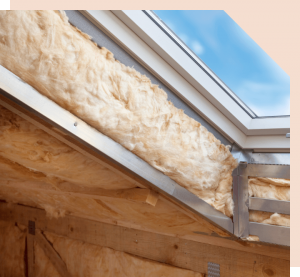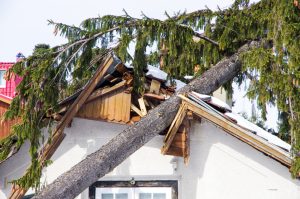Storm-Proofing Your Roof: Preparing for Extreme Weather
In the Chesapeake Bay area, where storms can be as unpredictable as they are intense, a sturdy roofing system is your home’s first line of defense. At Thunder Bay Roofing, serving Edgewater, Annapolis, Bel Air, Severn, MD, and surrounding areas in Maryland, we understand the critical importance of a storm-resistant roof.
Our leading Edgewater contractors, Nick Perz, and Steven Friedman, have seen firsthand the devastation extreme weather can wreak on unprepared homes. In this comprehensive guide, we’ll walk you through the essential steps to stormproof your roof and protect your home from Mother Nature’s fury. You can also learn more about keeping your home safe during storm season by calling our Chesapeake Bay contracting company at 410-956-7663.
Why Storm-Proofing Matters
Your roof is more than just the top layer of your home; it’s a complex system designed to protect everything beneath it. With climate change leading to more frequent and severe weather events, making sure your roof can withstand extreme conditions is more crucial than ever. From high winds and heavy rain to hail and flying debris, a well-prepared roof can mean the difference between minor repairs and catastrophic damage.
Assessing Your Roof’s Current Condition
Before embarking on any storm-proofing measures, it’s essential to understand your roof’s current state. Start with a thorough inspection. Look for signs of wear, previous damage, or weak points that could be exacerbated during a storm.
Key areas to assess include:
- Age and general wear of roofing materials
- Signs of previous storm damage (missing shingles, dents from hail)
- Weak points around chimneys, vents, and other protrusions
- Condition of flashing and seals
Essential Storm-Proofing Measures
Once you’ve assessed your roof, it’s time to implement storm-proofing measures. It’s not just about repairing existing damage; it’s about fortifying your roof to withstand future storms.
Key storm-proofing steps include:
- Reinforcing Roof Decking: Use ring-shank nails to secure roof decking to trusses or rafters. This additional strength can prevent your roof from lifting during high winds.
- Installing Impact-Resistant Shingles: Consider upgrading to Class 4 impact-resistant shingles. These are designed to withstand hail and flying debris, common threats during severe storms in the Chesapeake Bay area.
- Properly Sealing Roof Edges and Protrusions: Apply roofing cement under shingle tabs at the roof’s edges and around protrusions like chimneys and vents. This extra sealant helps prevent wind and water from getting underneath.
- Upgrading Flashing and Waterproofing: Install heavy-duty flashing around chimneys, skylights, and other roof penetrations. Consider a secondary water barrier for added protection against leaks.
The Role of Proper Ventilation and Insulation
Proper attic ventilation and insulation play a crucial role in maintaining your roof’s integrity during storms. Good ventilation helps regulate temperature and moisture levels in your attic. This prevents ice dams in winter and reduces the risk of shingles buckling in summer heat.
Be sure your attic has:
- Adequate intake and exhaust vents
- Proper insulation to maintain consistent temperatures
- No blockages in ventilation pathways
Gutter System Upgrades for Extreme Weather
Your gutter system is critical for directing water away from your home’s foundation. During heavy rains, properly functioning gutters can prevent water from backing up under your shingles or seeping into your basement.
Consider these gutter upgrades:
- Reinforce gutter attachments to withstand heavy water flow
- Install gutter guards to prevent clogs from leaves and debris
- Ensure downspouts direct water at least three feet away from your foundation
Tree Management Around Your Property
Trees can pose a significant threat to your roof during storms. Regularly inspect trees near your home and:
- Trim branches hanging over your roof
- Remove dead or diseased trees that could fall during high winds
- Consider the potential impact of trees on your property and neighboring properties
Regular Maintenance and Inspections
Proactive maintenance is key to a storm-resistant roof. Schedule professional inspections at least twice a year, ideally before and after storm season.
In between professional inspections:
- Conduct visual checks from the ground after storms
- Look for missing or damaged shingles, signs of leaks, or damaged flashing
- Clear debris from your roof and gutters regularly
Cost vs. Benefit Analysis of Storm-Proofing
While storm-proofing measures require an upfront investment, they can lead to significant long-term savings. The cost of properly storm-proofing your roof is often far less than the cost of major repairs or replacement after severe weather damage.
Consider the following:
- Potential insurance premium reductions
- Increased home value and curb appeal
- Peace of mind during storm seasons
Learn How To Protect Your Home for the Long Haul, Call Today!
Storm-proofing your roof is an investment in your home’s longevity and your family’s safety. By taking proactive steps to reinforce your roof, maintain your property, and stay prepared for emergencies, you can face extreme weather with confidence.
Don’t wait for the next storm warning to secure your home. Contact Thunder Bay Roofing today at 410-956-7663 to schedule a comprehensive roof assessment and learn more about our storm-proofing services. Let us help you turn your roof into a fortress against extreme weather, providing peace of mind for you and your family for years to come.






